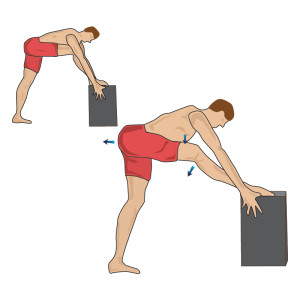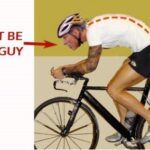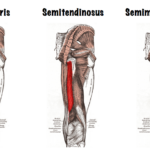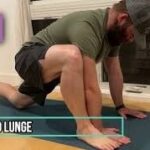Hamstring strains, or tears, are a common occurrence in runners and sprinters. There are several contributing factors to hamstring strains and there is a high chance of recurring injury. Strains in the hamstrings are more frequent than in some other muscles for several reasons: muscle imbalance, excessive neural tension (tonus), lack of flexibility, fatigue, and insufficient warm up are just a few of the factors that play a role in this type of injury. Anatomy

Depicted is the back of your right leg
Before I go any further, I’d like to explain the location and function of the hamstrings. They are three muscles on the back of your thigh, between the pelvis and the knee. All three of these muscles begin, or originate, at the Ischial Tuberosity (your sitting bone). The first muscle you see in the picture above is the Biceps Femoris (BF). The BF is logically named because it has two heads; the long head and the short head. The BF terminates, or inserts, at the head of the fibula (outside of your knee), and is the more common location of hamstring tears. The second muscle depicted above, the Semitendinosus, is located more medial than the others. This muscle terminates just below the inside of your knee. Finally, the Semimembranosus, is located between the others. The end of this muscle is also just below the inside of your knee.
You can feel all three of these muscles while sitting down. Just reach behind your knee and you’ll feel a hard tendon just above the knee, on the outside. You will feel two other tendons on the inside of your knee. The BF is on the outside, by itself, and the other two are on the inside.
Usually, strains will occur at the musculotendinous junction, or where you see red changing to white in the picture above. At the onset of injury, you will feel, or hear, a loud pop (*only for grade II strains – most runners we see will not have that experience). This is followed by some possible bruising to the lower leg, pain to the touch, and pain while stretching.
Role of the Hamstrings
The hamstrings are multi-articulate muscles, meaning that they provide movement for several joints. The main action is extending your thigh (kicking straight behind you). They also bend your knee and provide the rotational ability of your knee (only when it’s bent). Any multi-articulate muscle will have a higher chance of strain, but the hamstrings are generally more easily strained than others. As stated above, this is due to several factors. We will stick with the most frequent cause of hamstring strains: muscular imbalance.
Cause of strains: muscle imbalance
Located opposite the hamstrings are the Quadriceps. A strength or tonus imbalance between the two groups is often the cause of strains during running or sprinting. While sprinting, just before heel contact, your hamstrings are in a fully extended position. They are stretched out fully, while the quadriceps group is shortened. If there is a hefty imbalance, your hamstrings may be hyperextended. This hyperextension makes it extremely difficult for your hamstrings to contract fully. When you hear that “pop”, your hamstrings are generally fully extended.
How to prevent strains
Prevention of this type of injury is paramount, as the chance for recurrence is high, and recovery may take several weeks or months. Stretching will help decrease the tonus in your hamstrings, also increasing your stride length. Massage and bodywork will break up scar tissue and adhesions between the muscle bellies. You can also help reduce strength imbalances by seeing a certified personal trainer, or coach. Some passive stretches you can perform for self-care are explained below.
My personal favorite, a bent leg stretch, can be very effective for stretching the distal end of your hamstrings, closer to the knee. To perform this stretch, all you need is a set of stairs. Stand on the landing and place your target leg a few steps higher than the other. You want your hip, as well as your knee, to be at 90 degree angle. From there, you can gently try to straighten the knee joint, while the hip joint is kept in position. This stretch is depicted below. If you want to target the BF specifically, just turn your foot slightly inward before attempting to extend your knee. This can be helpful because the BF is commonly strained.
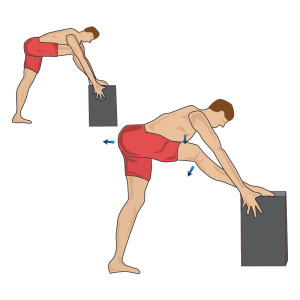
An effective stretch for the full muscle belly is the straight leg hamstring stretch. To perform this one, stand on the landing of your stairs again and place your target leg up a few stairs so that your knee is fully extended and your hip is at a right angle in front of you. This stretch is depicted below.
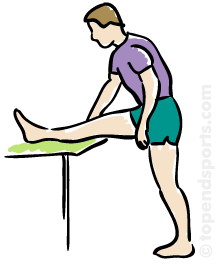
As with all passive stretching, be gentle and do not “bounce” into the stretch. After your run or training, gently hold the positions for ~30 seconds 2-3 times per side. If there is any pain during the stretch, stop. Pain is not gain in this instance. if you lack the mobility to perform these stretches, you can always make an appointment at our office where we can assist in increasing your range of motion.
Below, I have embedded a video, made by one of our colleagues, showing you exactly how to perform these stretches in self-care. All you need to get the most out of these mobility exercises is a strong rope, or band. When referring to the “distal” end of the hamstrings, we mean the area closest to the knee. When referring to the “proximal” end, we are referring to the section nearest the hip.
Thank you for reading! Be safe and careful with your training, and remember to always stretch!
References:
- Werner, R. (2009). A massage therapist’s guide to pathology. Baltimore, MD: Wolters Kluwer/Lippincott Williams & Wilkins.
- Salvo, S. G. (2011). Massage therapy: Principles and practice, S.l.: Elsevier Saunders.
- Kendall, F. P., McCreary, E. K., & Provance, P. G. (1993). Muscles, testing and function: With Posture and pain. Baltimore, MD: Williams & Wilkins.
- “Yoga Integrated Science.” Yoga Integrated Science. 2016. Web. 30 Mar. 2016.
- The Best Hamstring Building Tips And Workouts From The Forums! (2006). Retrieved March 25, 2016, from http://www.bodybuilding.com/fun/weik17.htm
Illustrations:
- Fig. 1: Retrieved April 1st, 2016, from: https://yogaintegratedscience.com/could-your-yoga-be-making-you-hamstrings-tighter/
- Fig. 2: Standing Hamstring Stretch. (n.d.). Retrieved March 25, 2016, from http://www.docpods.com/Hamstring-Stretch-Standing
- Fig. 3: Retrieved April 1st, 2016, from: http://www.topendsports.com/medicine/stretches/hamstring-standing.htm
This article/video is for educational purposes only; do not attempt without your physician’s clearance. If you are in pain or injured, see your physician.
Copyright © Vidal Sports LLC 2018




